It's all about the classical music composers and their works from the last 400 years and much more about music. Hier erfahren Sie alles über die klassischen Komponisten und ihre Meisterwerke der letzten vierhundert Jahre und vieles mehr über Klassische Musik.
Total Pageviews
Showing posts with label Beethoven. Show all posts
Showing posts with label Beethoven. Show all posts
Thursday, October 30, 2025
Friday, May 23, 2025
What Music Did Composers Choose For Their Funerals?
by Emily E. Hogstad
Music is always an important part of any funeral service or memorial service.
The right choice of music can pay tribute to the deceased’s tastes and provide comfort to the mourners left behind.
Have you ever wondered what music the great composers had performed at their funerals? Today, we’re looking at four fascinating composer funerals – and the music that was played at each of them.
George Frederic Handel (1759)
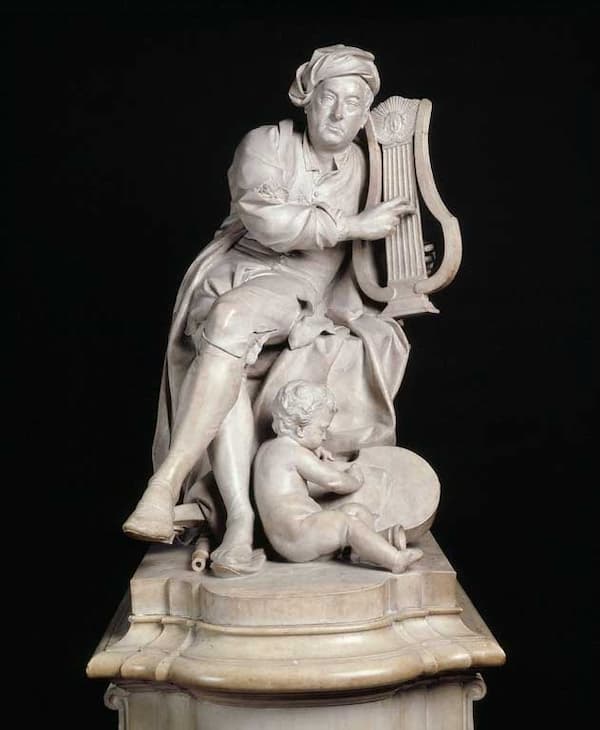
Marble statue of Handel, 1738
In August 1751, sixty-six-year-old composer George Frederic Handel developed a cataract in one eye. His vision began deteriorating, especially after a procedure conducted by a quack surgeon.
By the following year, he was totally blind and no longer able to compose.
He died in 1759. Although he had been born in present-day Germany, he had become a celebrity during his time in England. Accordingly, he was granted the privilege of a state funeral at Westminster Abbey.
He died on 14 April, and his funeral was held on 20 April. The Bishop of Rochester officiated, and over three thousand mourners attended.
Three choirs collaborated on a performance of Funeral Sentences by composer and organist William Croft.
These works have been performed at many famous British funerals since, including Winston Churchhill’s, Princess Diana’s, and Queen Elizabeth II’s.
Wolfgang Amadeus Mozart (1791)
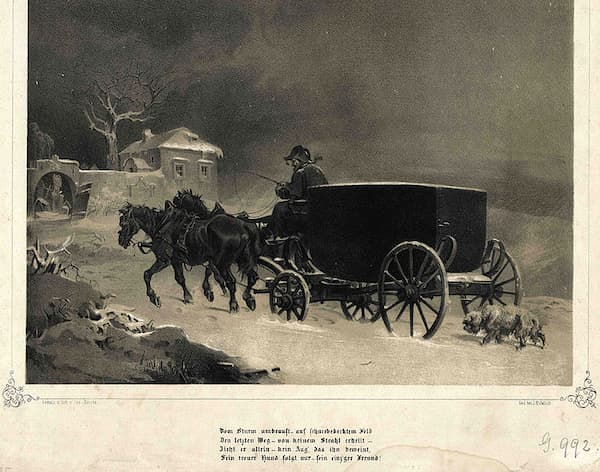
Engraving (1860) representing Mozart’s burial © wordsmusicandstories.wordpress.com
Historians disagree about the cause of Mozart’s death and the length of his health decline during the autumn of 1791.
However, it is known that by 20 November, he was bedridden, in pain, and vomiting.
He died on 5 December at his home, a little after midnight. The Requiem he was working on was left unfinished.
Mozart’s funeral was planned by his friend and patron Baron Gottfried van Swieten. It took place on 10 December at the parish of St. Michael in Vienna.
A portion of his unfinished Requiem was played at the service. The only movement that Mozart had completed and that was ready for performance was the opening “Requiem aeternam” from the Introitus section.
Scores for a few more movements based on sketches were quickly rounded out by Mozart’s student Franz Jacob Freystädtler, who completed the unfinished portions of the remaining movements, such as the Lacrymosa, Sanctus, and Benedictus.
Completion of the other movements was later tackled by another Mozart student named Franz Xaver Süßmayr.
The musicians who performed at Mozart’s funeral volunteered their services to pay tribute to their dead colleague.
Learn more about Mozart’s funeral.
Ludwig van Beethoven (1827)

Beethoven’s funeral as depicted by Franz Xaver Stöber © Wikipedia
By the time of his death in 1827, Beethoven’s health had been deteriorating for years.
Of course, his deafness was his most famous health complaint, but he also struggled with liver failure, pneumonia, and alcohol addiction.
He died in the early evening of March 26.
The funeral was a massive event. It is estimated that between 10,000 and 30,000 mourners lined up on the surrounding streets to pay tribute, or at least catch a glimpse of him.
His pallbearers included composer Johann Nepomuk Hummel, piano pedagogue Carl Czerny, and composer Franz Schubert.
Beethoven had not left specific instructions about what music he wanted to have performed at his funeral. Conductor and composer Ignaz von Seyfried took on the responsibility of providing music for the event.
Seyfried picked out two of Beethoven’s Three Equals, works for trombone ensemble that had been commissioned for All Souls’ Day in 1812. Seyfried rearranged them to include a men’s chorus.
Next he arranged the third movement of Beethoven’s Piano Sonata No. 12, a funeral march, again for trombone and men’s chorus.
He also conducted a “Chorale of the Brethren of Charity” from incidental music for Wilhelm Tell by now-forgotten composer Bernhard Anselm Weber.
To wrap it up, Seyfried offered his own “Libera me”, which quoted Mozart’s Requiem.
The bigger musical tribute came a few days later after the funeral proper at a commemorative performance. There the entire Mozart Requiem was performed in full.
Learn more about Beethoven’s funeral.
Frédéric Chopin (1849)
Pianist and composer Frédéric Chopin had endured severe chronic illness throughout his adult life.
However, during the 1840s, it became clear that his tuberculosis infection was likely going to kill him.
In 1842, he wrote to a friend that he was so sore and fatigued that he was lying in bed for the day.
On 15 October 1849, it became clear that the end was finally near. Musical visitors came and performed for him to provide comfort. He finally died on 17 October.
The funeral took place on 30 October. Chopin’s fame was such that tickets had to be printed for the event. Thousands of people came from around Europe to pay tribute, but only four thousand ticketed mourners were allowed into the Church of the Madeleine.
The music had been carefully chosen by Chopin himself and included Mozart’s Requiem. The archbishop himself had to issue special dispensation to allow women singers to sing in church, as long as they performed behind a black curtain.
Other musical offerings included organ arrangements of his fourth and sixth piano preludes, as well as the funeral march from his Piano Sonata No. 2.
For more of the best in classical music, sign up for our E-Newsletter
Friday, January 10, 2025
Seven Works Dedicated to Robert Schumann
by Emily E. Hogstad January 8th, 2025
Robert Schumann was one of the leading figures of classical music’s Romantic Era. His music – by turns tempestuous and ecstatic and always heartfelt – made a huge impression not only on audiences but on his fellow composers, too.
Today, we’re looking at seven works that Robert Schumann’s friends and colleagues wrote as tributes to him and his genius.

Josef Kriehuber: Robert Schumann, 1839
Frédéric Chopin: Ballade No. 2 (1836-39)
Frédéric Chopin and Robert Schumann had a bit of an awkward relationship. Schumann raved about Chopin’s music in his music journalism, but Chopin seems to have had a cooler opinion about Schumann’s work.
They met twice. The first time was in 1835 when Chopin was passing through Leipzig after visiting his parents. Schumann wrote about the encounter with great enthusiasm in his diary, but if Chopin ever recorded his impressions of the meeting, such an account hasn’t survived.
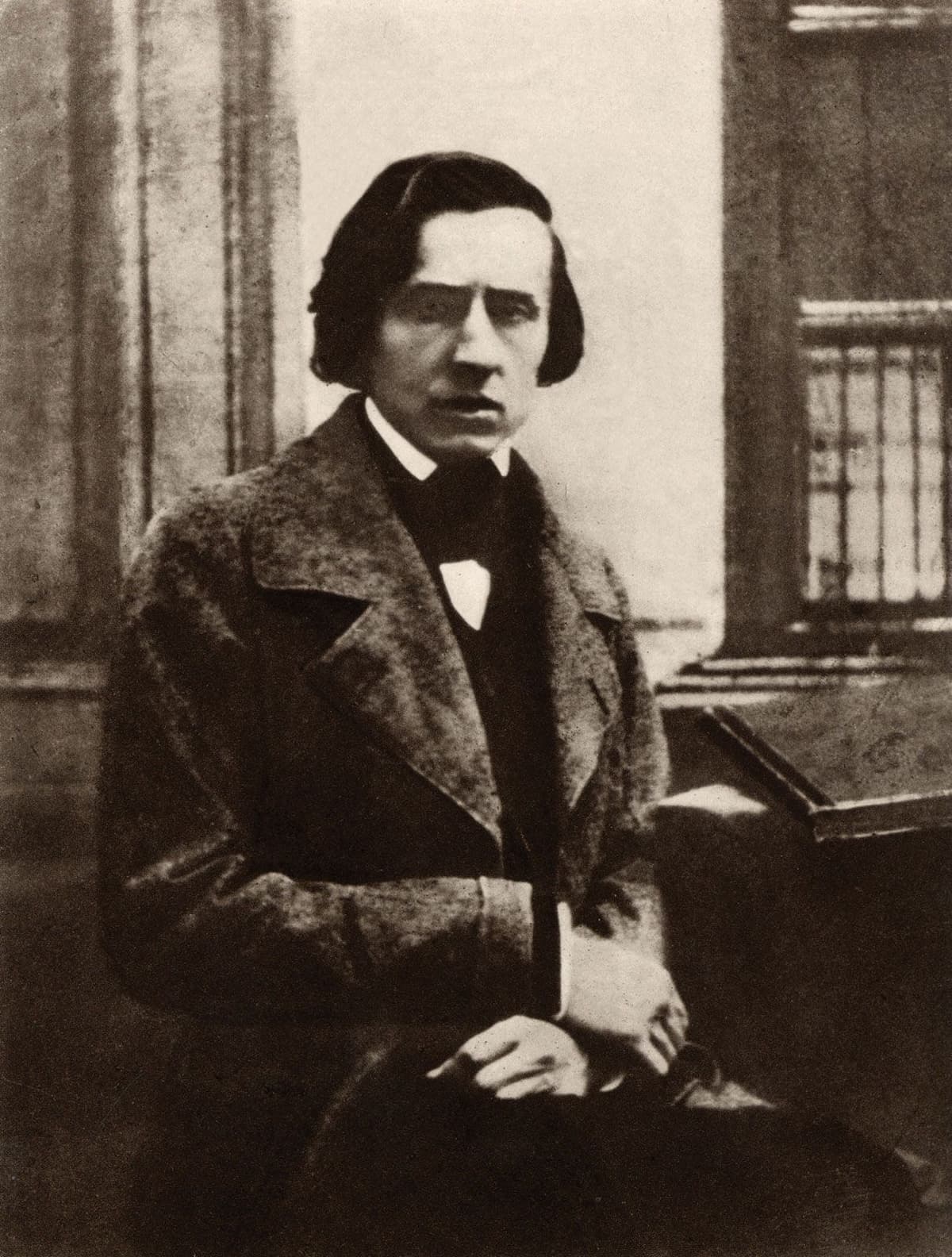
Frédéric Chopin
The second and final time was in 1836. Schumann tried initiating the meeting via letter but got no response. Then, one day, he arrived home to find Chopin waiting at his doorstep! They played music for one another, and Robert’s soon-to-be-wife Clara Wieck joined them.
After the visit, Schumann dedicated his Kreisleriana to Chopin, calling him “my friend” on the dedication page. Chopin reciprocated by dedicating this Ballade to Schumann…but was much more formal, dedicating it to “Mr. Robert Schumann,” and (perhaps pointedly) making no mention of friendship.
William Sterndale Bennett: Fantaisie, Op.16 (1837)
William Sterndale Bennett was a British pianist, composer, and conductor who was born in 1816.
He began composing at an early age, and several big names in European music were very impressed by him. Felix Mendelssohn invited the young man to Leipzig, where he met Robert Schumann. All three men deeply admired each other’s work.
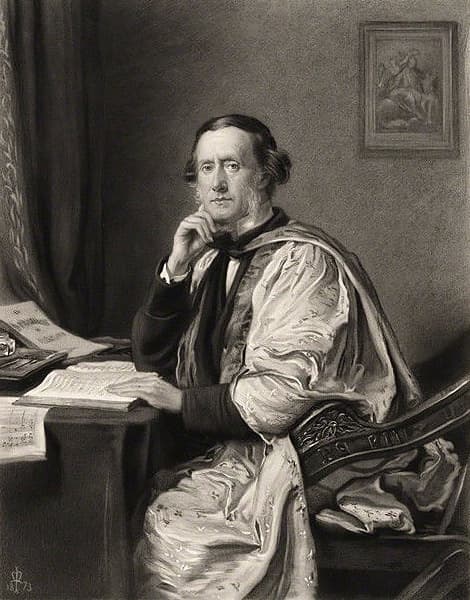
William Sterndale Bennett
In 1837, the year he turned twenty-one, Bennett began teaching at the Royal Academy of Music in London. He also wrote this four-movement “Fantaisie” for solo piano and dedicated it to his friend and mentor Robert Schumann.
Clara Wieck Schumann: 3 Romances, Op.11 (1839)
Robert Schumann admired many composers, but the one he loved the most was his girlfriend and later wife, Clara Wieck Schumann, who he married in September 1840, a day before her twenty-first birthday.

Andreas Staub: Clara Wieck, 1839
Their courtship was stormy. Her father disapproved of the match and went to court to try to prevent it. There were periods of time when the two were separated against their wills or when Clara was away concertising in the capitals of Europe. But they always found their way back to each other.
It is tempting to read her longing for Robert into these three-yearning works for solo piano that she dedicated to him in 1839, the year before their marriage.
Ignaz Moscheles: Cello Sonata No. 2 (1850-51)
Ignaz Moscheles was born in 1794 in Prague. He was a talented pianist and composer, and was one of the earliest champions of the music of Beethoven.
As a young man, he made sensational impressions on audiences touring through Europe. One of the listeners particularly affected by his piano playing was none other than Robert Schumann.

Ignaz Moscheles
Moscheles enjoyed a great friendship with the Mendelssohn family due to their Jewish heritage, passion for music, and Moscheles’s acknowledgement of Mendelssohn’s genius. Moscheles and the Mendelssohns were also friends with the Schumanns. (Moscheles even played a three-harpsichord concerto with Clara Schumann once – an unusual sight in the mid-nineteenth century!)
Given their overlapping friendships, it makes sense that Moscheles dedicated this charming Romantic cello sonata to Robert Schumann.
Woldemar Bargiel: Piano Trio No. 1 (1851)
German composer Woldemar Bargiel’s origin story was complicated.
Bargiel’s mother Mariane Tromlitz was a professional singer. In 1816, she married a demanding piano teacher named Friederich Wieck and had five children with him, among them a prodigy pianist named Clara.
In 1824, unable to endure her marriage any longer, Mariane divorced Wieck and (awkwardly) married Wieck’s best friend Adolphe Bargiel instead. She eventually had three more children with Adolphe, including Woldemar.
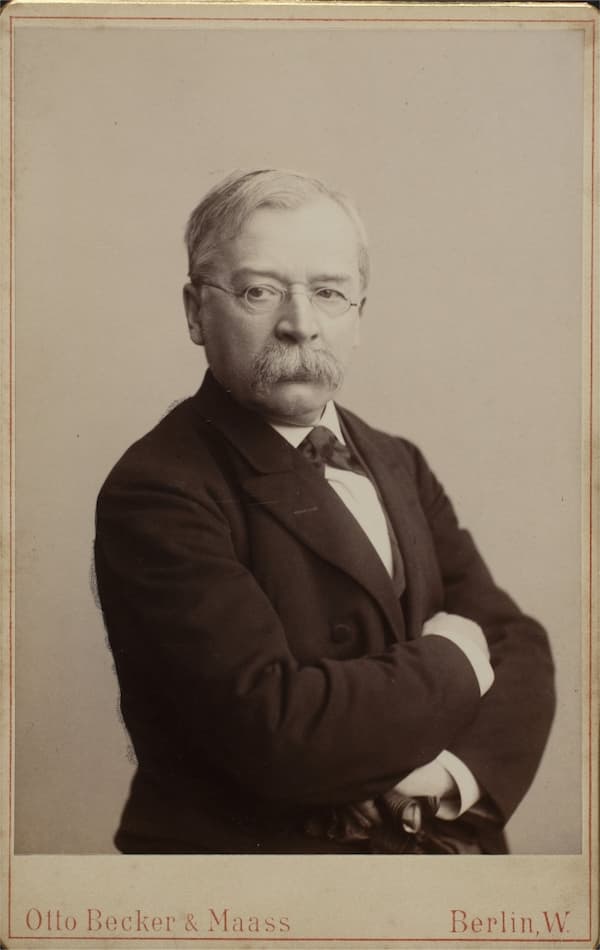
Woldemar Bargiel
It worked out well for the young and musical Woldemar to have a brilliant half-sister pianist nine years his senior. She gave career advice and provided him introductions to giants like Mendelssohn and Schumann. Their social circle suggested that he study at the Leipzig Conservatory, which he did between the ages of eighteen and twenty.
In 1848, he moved to Berlin to pursue his career there. This piano trio was written in 1851 and was unpublished for five years until Robert and Clara Schumann worked their connections so that it could be printed. In gratitude, he dedicated it to Robert.
Franz Liszt: Piano Sonata in B-minor (1852-53)
Clara Wieck Schumann and Franz Liszt had a rocky professional relationship. It started out positively. When she was a young girl, she was awed by his virtuosity, and for his part, Liszt found her compositions impressive, “especially for a woman,” as he reported to his partner, Marie d’Agoult.

Franz Hanfstaengl: Franz Liszt, 1858
But as the years went on, Clara became more and more leery of his brash style and willingness to depart from the score.
An all-out feud erupted in 1848 when Liszt called Robert Schumann’s Piano Quintet “typically Leipzig”, which insulted Clara. But Robert smoothed things over, to Clara’s irritation; in her artistic maturity, she didn’t want anything to do with Liszt’s style of music-making.
In 1854, Liszt published this piano sonata and dedicated it to Robert Schumann. Not surprisingly, Clara had a strong reaction, writing in her journal:
Today, Liszt sent me a Sonata dedicated to Robert and some more pieces, together with a polite note. But those pieces are so creepy! Brahms played them to me and I felt really miserable … This is only blind noise – no more healthy thoughts, everything is confused, one cannot see any clear harmonies! And, what is more, I still have to thank him now – this is really awful.
Despite her disgust, Liszt cheerfully retained his admiration for her music and her playing.
Clara Wieck Schumann: Variationen über ein Thema von Robert Schumann, Op.20 (1853)
It’s fitting that the final work on this list is another one of Clara’s.
This set of variations on a theme originally composed by Robert was written as his 41st birthday present. She wrote it in less than a week.
In this work, Clara includes references to multiple pieces of music by her husband, herself, and Felix Mendelssohn (who had died young and unexpectedly a few years before).
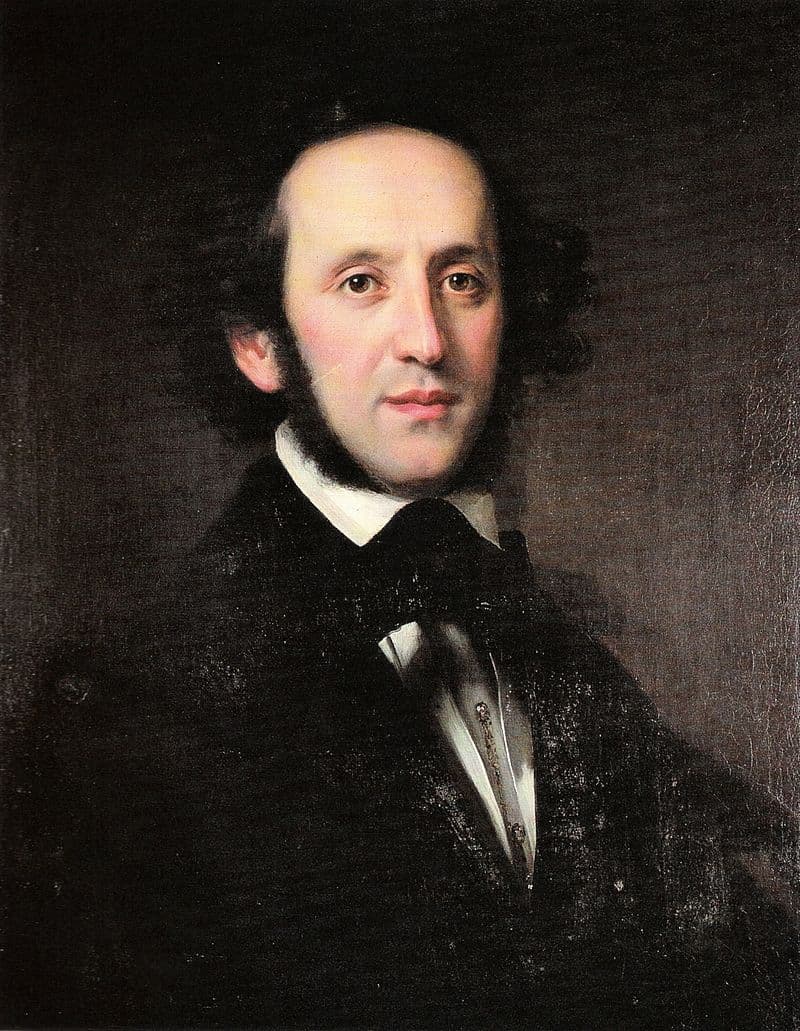
Eduard Magnus: Mendelssohn, 1846
It was one of the last musical projects they shared. Over the winter, Robert’s mental health deteriorated. In February 1854, he nearly died by suicide after jumping off a bridge into the Rhine River. It was determined that he needed to go to an asylum for his own safety. He died in the asylum in 1856. Clara would only be allowed to see him once more, shortly before his passing.
To comfort her, Johannes Brahms wrote his own variations for Clara based on this work after Robert had been institutionalised. It may not be dedicated to Robert officially, but it certainly was dedicated to him in spirit, so here it is as a bonus. We wrote about it here.
Friday, May 24, 2024
10 Pieces of Classical Music About Freedom
by Emily E. Hogstad
Classical music has been used for political purposes countless times, both in oppressive regimes (like in Stalin’s Soviet Union and Nazi Germany) and in battles for self-determination and freedom (like in the Finnish independence movement). European revolutions have had classical music as their soundtrack for a very long time.

© jewishjournal.com
Today, we’re looking at ten pieces of classical music about freedom, from Beethoven’s opera set in prison to Undine Smith Moore’s defiant piano music about the experience of being Black in America.
Let’s get started:
Ludwig van Beethoven: Leonore Overture No. 3 (1806)
In Beethoven’s opera Fidelio, a Spanish nobleman named Florestan threatens to expose the corruption of a colleague named Pizarro. Pizarro wrongfully imprisons Florestan and tells the rest of the world that he has been killed.
However, Florestan’s wife, Leonore, refuses to believe the news. So she dresses up as a boy, renames herself Fidelio, and gets a job in the prison to find out what really happened to her husband.
By the end of the opera, Leonore ends up in front of her husband just before Pizarro actually goes to kill him. Pizarro, enraged, threatens to murder both husband and wife, but Fidelio/Leonore one-ups him by pulling out a gun, which puts an end to Florestan’s unjust imprisonment.
Beethoven had trouble writing an overture for this opera, and he wrote and discarded several versions. This one – known as the Leonore Overture No. 3 – is sometimes played after Leonore’s rescue of her husband.
Giuseppe Verdi: “Va, pensiero” from Nabucco (1841)
Verdi’s opera Nabucco tells the Biblical story of the Israelites’ exile in oppressive Babylon.
In the opera, the Israelite slaves sing it as they work, describing how, even in exile, their thoughts are with their homeland.
However, this was not the music’s only potential meaning in mid-nineteenth-century Italy. At that time, a movement for Italian independence and unification was gaining steam, and art and music helped to contribute to national pride and identity.
In 1844, a few years after the premiere of Nabucco, two brothers named Attilio and Emilio Bandiera were working for Italian unification when one of their followers betrayed them. They were taken into custody and died by firing squad, becoming martyrs for the cause.
Verdi did not necessarily endorse such a movement, but whether he liked it or not, his music likely contributed to the atmosphere that ultimately made the revolution possible.
Frédéric Chopin: Heroic Polonaise (1842)
Chopin was very proud of his Polish ancestry.
However, when he was twenty years old, he chose to leave Warsaw to make a musical career in a bigger city.
No sooner had he left for Vienna with his dear friend, political activist Tytus Woyciechowski, than Warsaw broke out into armed conflict.
The November Uprising in Warsaw lasted from November 1830 until October 1831. (Woyciechowski, for his part, as soon as he heard about the uprising, returned to Warsaw. Chopin stayed behind.)
The Poles fought their occupiers, the Russians, but were ultimately crushed.
Chopin was devastated when he heard about the outcome. He wrote in his journal, “Oh God! … You are there, and yet you do not take vengeance!”
Over the years that followed, he became increasingly obsessed with Polish identity. He began incorporating polonaises – a dance form that originated in Poland – into his piano music.
He also began dating Paris-based authoress George Sand, who backed the Polish cause in her writings. After he wrote the Heroic Polonaise, she drew a direct line between the Polonaise and other countries’ fights for freedom and self-determination, writing, “The inspiration! The force! The vigour! There is no doubt that such a spirit must be present in the [1848] French Revolution. From now on, this Polonaise should be a symbol, a heroic symbol.”
Pyotr Ilyich Tchaikovsky: 1812 Overture (1880)
The overture was commissioned to celebrate the completion of the Cathedral of Christ the Saviour in St. Petersburg.
Construction of the cathedral had started generations earlier as a gesture of thanksgiving to God after Napoleon’s ill-fated attempt to overtake Russia in 1812.
To celebrate the Russians’ preservation of their freedom, Tchaikovsky wrote an overture about the fight, featuring excerpts of the Marsaillaise and Russian folk songs.
He underlined the importance of the victory by writing parts for large orchestra, brass band, church bells, and even cannons.
Jean Sibelius: Finlandia (1899)
Finlandia is Sibelius’s single most famous work. It was written for the Press Celebrations of 1899, a Finnish event that protested press censorship by the Russian Empire.
In order to sidestep Russian censorship, the piece was initially performed under over-the-top innocuous titles like “Happy Feelings at the Awakening of Finnish Spring.”
However, the piece was not just about happy feelings; it was clearly also a rebellious call to arms against oppression.
Finlandia portrays struggle, then transitions into a serene melody symbolizing the noble spirit of the Finnish people. That serene melody might sound like an old hymn, but it was actually composed by Sibelius specifically for this work. The work ends with rousing energy.
Amy Beach: A Song of Liberty (1902)
American composer Amy Beach wrote A Song of Liberty for piano and women’s choir. In it, she set lyrics by Frank Lebby Stanton, the first poet laureate of Georgia.
The song traces themes about American national identity and liberty and how, in the narrator’s view, the American penchant for liberty stretches “from sounding sea to sea”, in words that echo Katharine Lee Bates’s lyrics for what later became known as “America the Beautiful.”
Hail to our Country! strong she stands,
Nor fears the war drum’s beat.
The sword of Freedom in her hands,
The tyrant at her feet!
Ethel Smyth: March of the Women (1910)
Composer Ethel Smyth was born in 1858 in Kent. She was a rebel from childhood, demanding to be allowed to study music in Europe and locking herself in her room until her father let her go.
Not surprisingly, she was a major supporter of the women’s suffrage movement. (She even taught activist Emmeline Pankhurst how to throw stones at windows.)
In 1910, she joined the Women’s Social and Political Union and actually went so far as to give up her musical career for two years to contribute to the movement.
She returned to music briefly in 1911 when she composed the March of the Women. During this time, she was arrested for her activism and imprisoned in Holloway Prison. Her fellow suffragettes would march in the prison yard singing the March while she’d conduct them leaning out the window with a toothbrush.
Undine Smith Moore: Before I’d Be A Slave (1953)
African-American composer Undine Smith Moore was born in Virginia in 1904 and died in 1989. By the end of her prolific career, she was known as “the Dean of Black Women Composers.” She often wove themes of the Black American experience into her work.
In 1953, she wrote a piece for solo piano called Before I’d Be a Slave. She described the program of the work:
It follows a program which I would hope is evident in the music without verbal explanation – in general:
In frustration and chaos of slaves who wish to be free
In the depths – a slow and ponderous struggle marked by attempts to escape-anyway-being bound-almost successful attempt at flight
Tug of war with the oppressors
A measure of freedom won – some upward movement less lacerating
Continued aspiration-determination-affirmation.
Dmitri Shostakovich: Symphony No. 11 (1957)
In his eleventh symphony, Dmitri Shostakovich turned to the story of the 1905 Russian Revolution for creative inspiration.
This symphony has often been described as a soundtrack without a movie. It’s easy to see why: the work lasts for an hour with no breaks, and every movement contains a program.
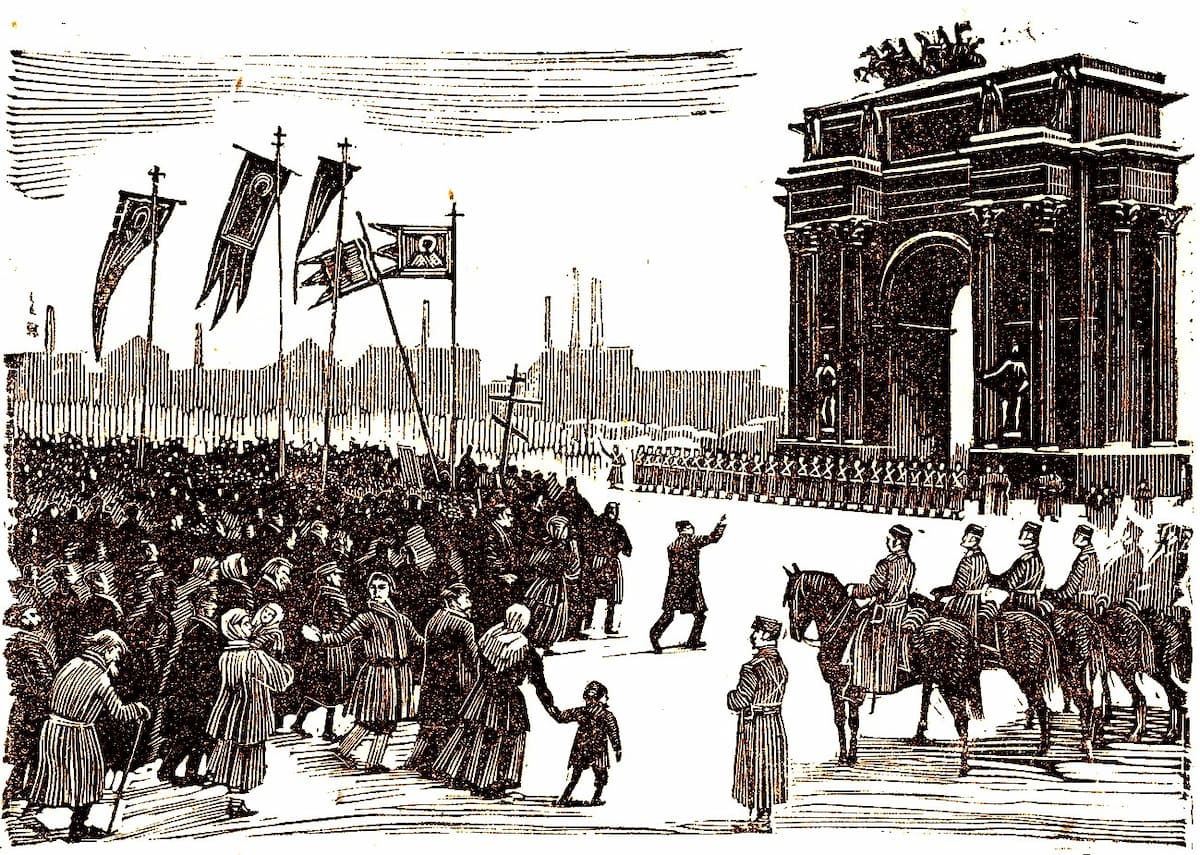
Demonstrations before Bloody Sunday © Wikipedia
The first movement is about the quiet in the Palace Square before unarmed protesters marching to the palace were shot by imperial forces. The second movement depicts the forces beginning to attack the crowd, while the third movement is a memorial to those who have just lost their lives. The finale hints at the 1917 revolution – in which the royal family was defeated once and for all.
It is possible – although not certain – that Shostakovich was inspired to write this symphony at least in part because he had sympathy for the Hungarian Revolution of 1956. Testimony about his political positions is abundant and often contradictory. But aside from all of that, it is very easy to read a narrative of struggle, liberty, and self-determination into this music.
Frederic Rzewski: The People United Will Never Be Defeated! (1975)
Some people believe that this is among the greatest sets of themes and variations ever composed! It was written by composer Frederic Rzewski, an American composer who lived between 1938 and 2021.
This work consists of a Chilean protest song, ¡El pueblo unido jamás será vencido! (The people united will never be defeated!), and 36 variations on it.
Rzewski wrote the work as a commentary on the popular resistance to oppressive dictator Augusto Pinochet, who came to power with the support of the American government in 1973.
The work is massive, lasting an hour, and is also massively demanding. For one, the score asks the pianist to whistle and slam the piano lid!
Conclusion
Whenever people feel oppressed by any force, it is second nature to create or take comfort in music that expresses the pathos, fury, tragedy, and occasionally triumph that can arise when seeking freedom…and these ten works of classical music about freedom prove it!
What’s your favorite classical music about freedom?
Friday, November 10, 2023
Famous Father, Famous Son! Franz and Richard Strauss
By Georg Predota , Interlude
Famous musical sons frequently have famous musical fathers. And Richard Strauss is no exception. In his day, his father Franz was recognized as an important artistic personality. Foremost, he became a celebrated horn virtuoso, by “breathing soul into the unthankful instrument.” Even Richard Wagner, against whom the musically conservative Strauss took literally every opportunity to make his disapproval clear, recognized his unusual talent. “Old Strauss is an unbearable fellow, but when he plays the horn one can’t really mind him.” Franz Strauss became a member of the Royal Court Orchestra in Munich in 1847, and set new standards on his instruments for more than four decades. However, he also dabbled in composition, predictably centered on his favorite instrument.
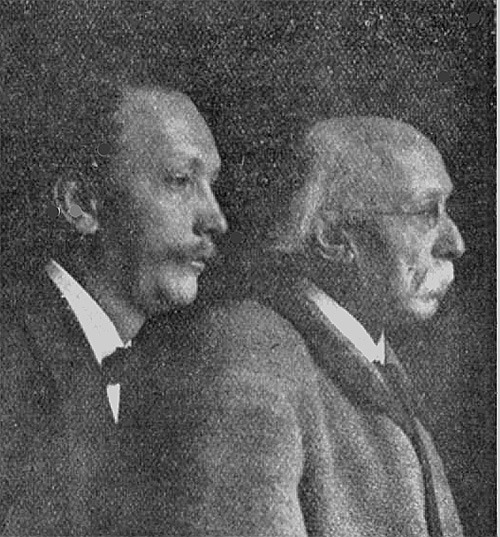
Franz and Richard Strauss © Wikipedia
Franz Strauss quickly recognized his son’s musical talent and entrusted four and a half-year-old Richard to August Tombo for piano lesson. Before long Richard was able to play the tunes in a book of operatic arrangements, and successfully tackled a Mozart sonata. His older sister remembered, “Richard made swift progress. Sight-reading presented him with no problems. His teacher played with him a great deal, and there was one trick that delighted Richard. His teacher played the bass part with the left hand, the top line with his right hand and the middle part with the tip of his long pointed nose.” Richard first tried his hands at composition at the age of six, when he composed the Schneider-Polka (Tailor Polka) for piano. However, as he was not yet capable of writing music, his father wrote it down for him.
Young Richard was described by his teacher as “a student with excellent dispositions, good deportment and well behaved; lively, enthusiastic, attentive, sometime over-eager and hasty.” By the time he was 18, Richard had composed roughly 140 compositions, including almost 60 songs and more than 40 piano works. Much of these juvenilia pay homage to the musical creed of his father, who favored the “trinity of Mozart (most of all), Haydn and Beethoven.” The first time Richard heard a Beethoven symphony he did not understand it, he remained unmoved and even said, “he didn’t care of it.” Nor did he understand Beethoven’s sonatas and quartets at that stage. “In his piano lessons he preferred Chopin, Mendelssohn and Bach.” When Richard made his pianistic debut on 20 October 1885, however, he played the Mozart C-minor Concerto with his own cadenzas, which are unfortunately lost. Echoes of Mozart and the Classical style clearly emerge in his Serenade in E-flat for Thirteen Wind Instruments, Opus 7, dedicated to his composition teacher Franz Meyer.

Franz Strauss ©hornarama.com
At age 21, Richard Strauss took up the post of assistant conductor of the Meiningen Orchestra. Hans von Bülow, a student of Franz Liszt and champion of the music of Richard Wagner and later Johannes Brahms had appointed him. To thank von Bülow, Richard composed a work for piano and orchestra originally titled “Scherzo in D minor.” Bülow considered it a “complicated piece of nonsense and unplayable” and refused to learn it. Strauss made some changes and renamed the work “Burleske” with Eugen d’Albert premiering the work in 1890. Bülow, however, was still not convinced and wrote to Johannes Brahms “Strauss’s Burleske decidedly has some genius in it, but in other respects it is horrifying.”
Throughout his life, Richard Strauss had the highest admiration for Hans von Bülow. “For anyone who ever heard him play Beethoven or conduct Wagner, who attended one of his piano lessons or observed him in orchestra rehearsal, he inevitably became the model of all the shining virtues of a performing artist, and his touching sympathy for me, his influence on the development of my artistic abilities, were the decisive factors in my career.”
Friday, September 29, 2023
How These Ten Pieces Can Help Writers Unlock Creativity
by Emily E. Hogstad
Writing is hard. It’s a lonely pursuit requiring not only focus and discipline, but inspiration, too.
While there are many tools and techniques that writers can use to boost their creativity, one often overlooked resource is classical music.

© helpingwritersbecomeauthors.com
Today we’re looking at ten famous pieces of classical music and why they might appeal to writers.
Whether you’re a seasoned pro or a writer or just starting out, here’s how these classical pieces can help you unlock your full potential and take your writing to the next level.
LUDWIG VAN BEETHOVEN: MOONLIGHT SONATA
This melancholy piece for solo piano will encourage writerly introspection, enabling authors to explore their deepest thoughts and feelings…even when those thoughts and feelings might be dark or sad.
Its mesmerizing triplet rhythm will help writers get into a meditative creative groove, too.
ANTONIO VIVALDI: THE FOUR SEASONS
The ever-shifting moods contained within these four timeless concertos by Vivaldi will inspire writers to weave a diverse range of emotions and experiences into their writing.
Here’s a hint: if you want a modern take on these concertos, try listening to Max Richter’s Recomposed, a reimagining of Vivaldi’s original music. It sounds like a movie soundtrack.
WOLFGANG AMADEUS MOZART: REQUIEM IN D MINOR
The haunting melodies and solemn nature of this masterpiece will help writers contemplate profound questions about life, death, and the human condition.
Mozart died young while writing the Requiem. Hopefully apart from the music, that story will encourage authors to seize the day and prioritize that writing project they’ve always dreamed about tackling.
J.S. BACH: GOLDBERG VARIATIONS
This intricate piece for keyboard will inspire writers to strive for perfection in their craft and pay attention to every little detail, just like Bach did.
The thoughtful complexity of the Goldberg Variations – like so much of Bach’s music, and Baroque music in general – can help writers of all kinds to get into a particularly productive flow state.
PYOTR ILYICH TCHAIKOVSKY: SWAN LAKE
The grandiose gestures of this iconic Romantic ballet will help writers channel their inner drama queen and imbue their writing with a sense of old-fashioned romance.
This is perfect music for when you’re writing characters experiencing fierce arguments, grand realizations, or passionate love affairs.
CLAUDE DEBUSSY: CLAIR DE LUNE
This dreamy, atmospheric solo piano piece will transport writers into a world of inspiration, enabling them to easily visualize the beauty of a moonlit night.
This piece would be perfect to listen to while writing quiet scenes between two characters, or the inner monologue of a character who is alone and lost in thought.
GEORGE FRIDERIC HANDEL: MESSIAH
The soaring melodies and powerful choral outbursts of Handel’s masterpiece will inspire writers to explore themes of faith, hope, and redemption, and infuse their writing with a sense of transcendence and wonder.
And again, like so much Baroque music, its propulsive rhythms will help writers get into that sought-after creative groove.
FRÉDÉRIC CHOPIN: NOCTURNES
The moody, atmospheric nature of these piano pieces evokes a sense of longing and introspection in any writer and will inspire them to delve into their characters’ inner worlds.
The nocturnes would be especially perfect for anyone writing historical fiction or Gothic drama. Nothing conjures up a Victorian parlor or doomed period romance like Chopin’s piano music!
Johannes Brahms: Symphony No. 1
The majesty of Brahms’ Symphony No. 1 will inspire writers to think big and aim for greatness, while the soaring melodies and powerful crescendos might give them ideas about how to build suspense and excitement in their own work.
This piece should also inspire every writer to keep at their craft and never give up, because this symphony took Brahms over twenty years to compose! The next time you have a bad writing day, think of Brahms and his persistence.
GUSTAV HOLST: THE PLANETS
Each movement of The Planets represents a different planet in the solar system, so you can imagine how dramatic this music gets!
It’s no coincidence that The Planets often sounds like movie music. Composer John Williams was deeply inspired by Holst’s portrait of the cosmos when composing his classic soundtracks.
These ten pieces of classical music are only the beginning. By taking the time to explore different genres, composers, and pieces, writers can tap into a rich source of inspiration – and in the process, unlock their full creative potential.
Happy writing!
Saturday, June 17, 2023
How Inspiration Strikes
By Georg Predota, Interlude
Composers tend to be a peculiar lot, particularly as it pertains to the best and most conducive circumstances in which they compose their best music. Of course, reports of that nature tend to be highly anecdotal, but more often then not, they do contain at least a kernel of truth.
Ludwig van Beethoven

Beethoven on a Walk by Berthold Genzmer
As the American painter, artist and photographer Chuck Close famously stated, “Amateurs sit and wait for inspiration, the rest of us just show up and go to work.” Beethoven, for example, went for vigorous walks through the forests and hills surrounding Vienna after lunch. He always carried with him a pencil and a small pocket sketchbook, recording any musical ideas that would thus come to his mind.
Gustav Mahler

Mahler’s Komponierhäuschen
Gustav Mahler not only locked himself in various Komponierhäuschen (Composer’s cottages), he also took 3 to 4-hour walks after lunch, recording his musical impressions in a notebook.
Benjamin Britten
For Benjamin Britten, afternoon walks were “where I plan out what I’m going to write in the next period at my desk”.
Richard Strauss
Richard Strauss preferred to compose in his garden cottage until lunchtime, when it was time to head for the local restaurant.
Christoph Willibald Gluck
Solitary walking, however, was clearly not the only source of inspiration for great musical minds. Gluck, it was said, wrote best when he was sitting in the middle of a field.
Gioachino Rossini
Rossini was most productive when he had partaken of “a good flask of wine.”
Wolfgang Amadeus Mozart

Mozart at the Pooltable by Oswald Charles Barret
It is said that Mozart composed his best music while playing billiards
Giovanni Paisiello
Paisiello enjoyed composing while lying in bed.
Antonio Sacchini
A pretty woman by his side, and his pet cats playing around his feet was a prerequisite for Sacchini to write well.
Giuseppe Sarti

© inhabitat.com
Sarti preferred to sit in a dark gloom lighted only by a single candle.
Domenico Cimarosa
Cimarosa composed his best works surrounded by a dozen of gabbling friends, with light conversation inspiring his music.
Étienne Méhul
Mćhul, on the other hand, trying to get away from the noise and bustle of the city. Once, he went to the Chief of Police in Paris and asked to be imprisoned in the Bastille.
Richard Wagner
And let’s not forget Richard Wagner, who liked his silken undies and heavy perfume in order to be properly inspired. He also needed perfect quiet, and nobody was allowed entrance to his study—it is reported that even his meals were passed to him through a trap door. Believe it or not!
Subscribe to:
Comments (Atom)